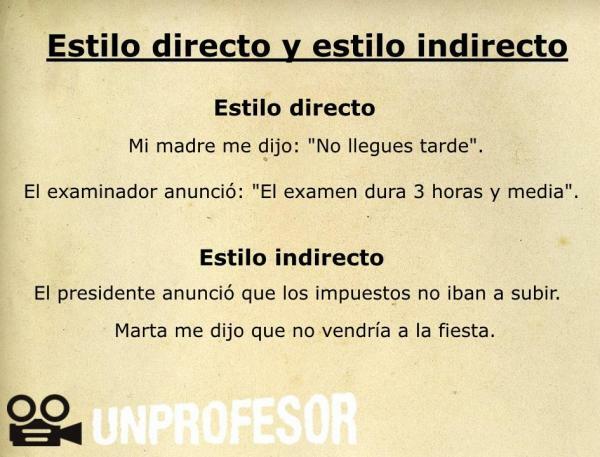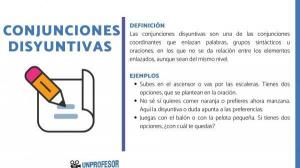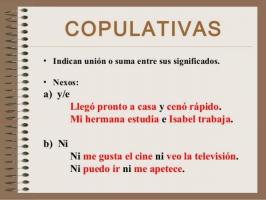DIRECT and INDIRECT style

Two of the narrative forms most used in Spanish when transmitting or telling what another person has told us are the direct style and the indirect style. With the first, the direct style, we literally reproduce each and every word that has previously been enunciated by the speaker, while with the indirect style we can introduce some variations on the message original. In this lesson from a TEACHER we will see what the direct and indirect style differences with examples and we will delve into the characteristics of each one. Keep reading!
Index
- What is the direct style
- What is indirect style
- Differences between direct style and indirect style
- Direct and indirect style: examples
- Direct and indirect style exercises - with solutions
What is the direct style.
As we have said before, the direct style allows us to transmit the message as we have received it. To do this, we use the graphic sign of the quotation marks
("") that delimits the information that we have heard from the other person. Another characteristic of the direct style is that the information in quotation marks is preceded by the two points (:) that indicate where the speech begins in direct style.In addition, the message is preceded by a declarative verb; the verb "say" is the most common, but we can also use "indicate", "ask", "affirm", "declare", "explain", "tell", and so on. Let's see some examples:
- My mother told me: "Don't be late."
- The student asked me the following: "What time does class end?"
- The examiner announced: "The exam lasts 3 and a half hours."
- The young people wrote in the banner: "We want more scholarships to study."
What is the indirect style.
In front of the direct style, indirect style allows us to reproduce the message using our own words and, for this, we must use the conjunction "what". Parallel to the direct style, the indirect style also makes use of communication verbs such as "clarify", "repeat", "enunciate", "affirm", "remember", etc. Here are some examples of indirect style:
- Your brother told me that he would be late for dinner.
- The president announced that taxes were not going to go up.
- Marta told me that she would not come to the party.
- The inmate claimed that he was innocent.
In this other lesson from a TEACHER you will be able to delve into this style, more specifically in the free indirect style with examples.

Image: Pinterest
Differences between the direct style and the indirect style.
Well, once we have explained what the direct style is and what the indirect style is, let's see what their differences are. The main difference between the two is that the indirect style allows us add some feedback to the information they have transmitted to us, while through the direct style we just limit ourselves to narrate the literal messageHence the need to use quotation marks.
When going from direct style to indirect style it is important to keep in mind that verb tenses, temporal or spatial expressions and pronouns they have to change to accommodate the new style of enunciation. For example:
- Lucia told me: "I think right now I need a change in my life."
- Lucia told me that she believed that at that moment she needed a change in her life.
In the previous sentences we clearly observe how there are some series of changes between one phrase and another: with the indirect style, the verb tenses go in the past ("believed", "needed"), the temporal references ("in this moment ") vary since the indirect style always refers to events that occurred in a past tense (" in that moment").
In addition, the pronouns that refer to the speaker himself, in the direct style they are in the first person ("my life") since, through the quotation marks, the message that the speaker enunciates is reproduced, while that, with the move to indirect style, the message is no longer transmitted by said person but by a third person, with which the first person pronoun is replaced by the third ("his life").

Direct and indirect style: examples.
So that you can better understand this part of theory that we have just indicated, below we are going to offer you examples of direct and indirect style in sentences. In this way, the concepts will be much clearer.
- Laura asked me to accompany her to the dance - INDIRECT.
- Laura told me: "Come with me to the dance" - DIRECT.
- She asked me if I wanted to marry her. - INDIRECT.
- "Do you want to marry me?" She said to me. - DIRECT.
- Lucia loved yesterday's movie. - INDIRECT.
- Lucia: I loved yesterday's movie! - DIRECT.
- Marcos didn't want to go shopping. - INDIRECT.
- "I don't want to go shopping," Marcos told me. - DIRECT.
Direct and indirect style exercises - with solutions.
And as a final culmination, we are going to propose some exercises of direct and indirect style that will help you to test yourself and what values for yourself if you have really understood this lesson. Below you will have the solutions, but we recommend that you do not look at them in advance so that the exercise is fruitful for you.
Statement: Indicate whether these sentences are direct and indirect in style.
- "I hope you come on vacation with me," Lucas told Julia.
- Paolo told me that this boy was her brother.
- Antonio: Why didn't you come to school yesterday?
- "What's your name?" Said the lady to the girl.
- The boy asked me if he had seen the neighbor in the room.
Solutions
- "I hope you come on vacation with me," Lucas told Julia. - DIRECT.
- Paolo told me that this boy was her brother. - INDIRECT.
- Antonio: Why didn't you come to school yesterday? - DIRECT.
- "What's your name?" Said the lady to the girl. - DIRECT.
- The boy asked me if he had seen the neighbor in the room. - INDIRECT.
If you want to read more articles similar to Direct and indirect style - Differences and examples, we recommend that you enter our category of Grammar and Linguistics.
Bibliography
- Mascioli, J. (2008). The direct and indirect style. Buenos Aires: National University of La Plata. Retrieved on, 26.
- van der Houwen, F. (2000). DIRECT SPEAKING VS. HINT. Analytical study of the linguistic sign: theory and description, 17, 27.
- Reyes, G. (1993). Citation Procedures: Direct Style and Indirect Style (Vol. 10). Arch books.


